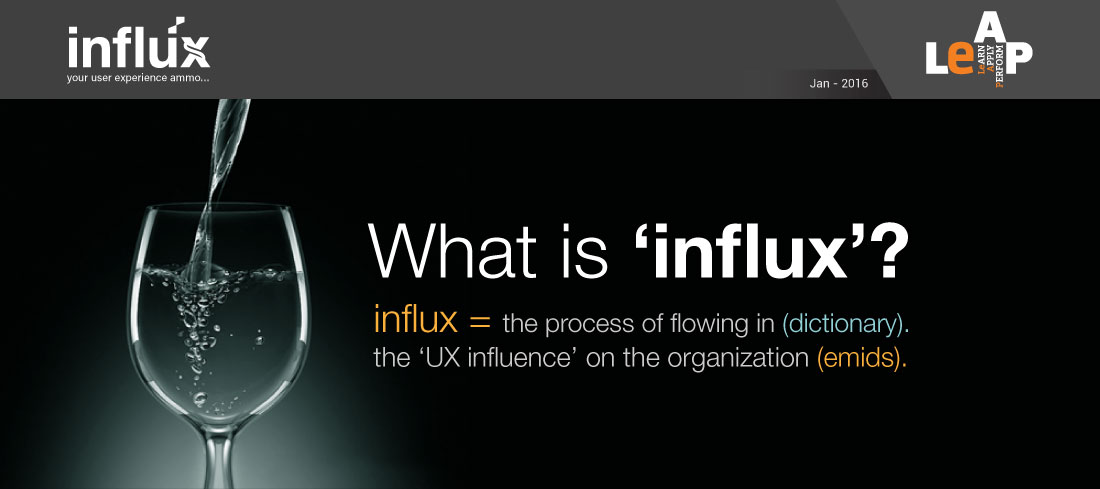Major UX Trends in 2016
We all agree that it’s good to think ahead. However, according to experts the future is already here–we’re just not taking advantage of it. The intention in the first edition of influx is not to predict UX trends, but to reflect on a few key areas and look at possible applications as we move into the thick of action in 2016.
Consistency across touch-points
Consistency is key to successful UX. That’s why companies are investing in specific UX tools and processes including guidelines, content libraries and digital asset management systems. This allows UX teams to deliver a consistent experience across products and digital touch-points. This requirement is heightened by the need to deliver consistent user experiences across different devices. Although user experiences should be consistent across devices, they should not be the same. It’s important to consider not only the different interfaces, for example, click becoming touches and scrolling becoming swiping, but also the user’s motivations and goals, as these are also likely to differ between devices. Understanding these subtle variations is vital! Have we at emids considered it? Something to reflect upon…
References:
http://continuuminnovation.com/consistency-and-multi-touchpoint-experience-design
Off-screen UX Design
User Experience has nearly always been associated with desktop screens and particularly the screen design on desktops alone, but it is beyond that. It first invaded your telephones though phone based voice systems and now your mobile and tablet screens and experiences too. As we begin the year, it’s important to be aware that digital is moving from something we use inside of screens and devices to something that lives in the everyday objects around us, and the places we move through. And therefore User experiences will play out across a bigger, messier ecosystem (yes including your clunky CLIs). Designing for this new reality will require thinking more broadly, considering how people touch a service across many points.
References:
http://mashable.com/2012/08/17/ux-ecosystem/#ALPQONTVhqqD/
An Increase in Voice Recognition and Gesture-Based Design
Dave Benton, Founder/Creative Director at Metajive predicts that 2016 is going to be another exciting year for the progression of User Experience. UX will progress not only visually but voice recognition technology will also start to emerge as a more accessible input. Visually with minimal design staying put, designers will continue to explore depth and layer for differentiation. As touch becomes more standard, we will continue to see not only a rise in the use of gestures, but also consistency in gestures across apps, devices and platforms. An area that we at emids need to start focusing on sooner or later.
References:
http://www.jnd.org/dn.mss/opportunities_and_ch.html
Motion User Interface or Motion UI
We could not help but mention a final note on Web/ UI Development trend called Motion UI. Motion UI is a Sass library which is one of the three parts of Foundation for Apps by Zurb. It is widely used for quickly creating animations and CSS transitions. With Motion UI, it is less complicated to make an app’s transitions look smooth and rich with predefined motions.
Motion UI’s prototypical animated elements integrate seamlessly into websites making it one of the most preferred libraries for developers. Last year, we saw an emerging trend of Motion UI which is sure to stay not only in 2016, but for the next few years.
References:
http://zurb.com/playground/motion-ui
Conclusion
User experience is a battle ground for service organizations trying to gain competitive advantage in increasingly digital industries. If service organizations are serious about providing outstanding digital customer service, it is imperative they invest in building user experience capability and continuous learning. Central to achieving this is an embedded culture of continuous improvement, focused on innovation and testing that promotes the best possible experience. Driving consistency of UX will also ensure the service our customers receive is on-brand and in-line with the overall experience you are trying to achieve across your touch-points.
Ultimately UX is where it all comes together, and in today’s digital world it can make or break your overall customer service experience. Something for all of us at emids to introspect and action it!

